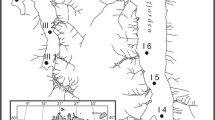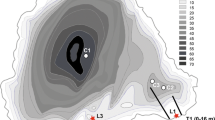Abstract
The hydroecology of floodplain lakes is strongly regulated by flood events. The threat of climate warming and increasing human activities requires development of scientific methods to quantify changes in the frequency of short-lived flood events, because they remain difficult to identify using conventional paleolimnological and monitoring approaches. We developed an approach to detect floods in sediment records by comparing the abundance and composition of epiphytic diatom communities in flooded and non-flooded ponds of the Peace-Athabasca Delta (PAD), Canada, that grew on submerged macrophytes (Potamogeton zosteriformis, P. perfoliatus) and an artificial substrate (polypropylene sheets) during the open-water season of 2005. Analysis of similarity tests showed that epiphytic diatom community composition differs significantly between flooded and non-flooded ponds. After accounting for the “pond effect,” paired comparisons of the three substrates determined that variation in community composition between the artificial substrate and macrophytes was similar to that between the macrophyte taxa. Similarity percentage analysis identified diatom taxa that discriminate between flooded and non-flooded ponds. The relative abundance of ‘strong flood indicator taxa’ was used to construct an event-scale flood record spanning the past 180 years using analyses of sedimentary diatom assemblages from a closed-drainage pond (PAD 5). Results were verified by close agreement with an independent paleoflood record from a nearby flood-prone oxbow pond (PAD 54) and historical records. Comparison of epiphytic diatoms in flooded and non-flooded lakes in this study provides a promising approach to detect changes in flood frequency, and may have applications for reconstructing other pulse-type disturbances such as hurricanes and pollutant spills.





Similar content being viewed by others
References
Amireault MC, Cattaneo A (1992) How artificial are artificial substrata for periphyton? J North Am Benthol Soc 11:244–256
Amoros C, Bornette G (2002) Connectivity and biocomplexity in waterbodies of riverine floodplains. Freshw Biol 47:761–776
Bailey P (1995) Understanding large river-floodplain ecosystems: significant economic advantages and increased biodiversity and stability would result from restoration of impaired systems. Bioscience 45:153–158
Battarbee RW, Kneen MJ (1982) The use of electronically counted microspheres in absolute diatom analysis. Limnol Oceanogr 27:184–189
Blindow I (1987) The composition and density of epiphyton on several species of submerged macrophytes—the neutral substrate hypothesis tested. Aquat Bot 29:157–168
Brown AG (2002) Learning from the past: palaeohydrology and palaeoecology. Freshw Biol 47:817–829
Clarke KR, Gorley RN (2006) Primer v6: user manual/tutorial. PRIMER-E Ltd, Plymouth
Clarke KR, Warwick RM (2001) Change in marine communities: an approach to statistical analysis and interpretation, 2nd edn. Plymouth, UK
Coops H, Buijse LL, Buijse AD, Constantinescu A, Covaliov S, Hanganu J, Ibelings BW, Menting G, Navodaru I, Oosterberg W, Staras M, Torok L (2008) Trophic gradients in a large-river delta: ecological structure determined by connectivity gradients in the Danube Delta. River Res Appl 24:698–709
Corell RW (2006) Challenges of climate change: an Arctic perspective. Ambio 35:148–152
Forsberg BR, Devol AH, Richey JE, Martinelli LA, Dos Santos H (1988) Factors controlling nutrient concentrations in Amazonian floodplain lakes. Limnol Oceanogr 33:41–56
Hall RI, Smol JP (1996) Paleolimnological assessment of long-term water quality changes in south-central Ontario lakes affected by cottage development and acidification. Can J Fish Aquat Sci 53:1–17
Hay MB, Smol JP, Pipke KJ, Lesack LFW (1997) A diatom-based paleohydrological model for the Mackenzie Delta, Northwest Territories, Canada. Arct Alp Res 29:430–444
Izaguirre I, O’Farrell I, Unrein F, Sinistro R, dos Santos AM, Tell G (2004) Algal assemblages across a wetland, from a shallow lake to relictual oxbow lakes (Lower Parana River, South America). Hydrobiologia 511:25–36
Janauer GA, Kum G (1996) Macrophytes and floodplain dynamics in the river Danube ecotone research region (Austria). Hydrobiologia 340:137–140
Jungwirth M, Muhar S, Schumtz S (2002) Re-establishing and assessing ecological integrity in riverine landscapes. Freshw Biol 47:867–887
Junk WJ, Bayley PB, Sparks RE (1989) The floodpulse concept in river–floodplain systems. In: Dodge DP (ed) Proceedings of the international river symposium. Canadian special publication of fisheries and aquatic sciences, vol 106, pp 110–127
Krammer K, Lange-Bertalot H (1986–1991) Bacillariophyceae. Süsswasserflora von Mitteleuropa. Band 2 (1–4), vols. 1–4. Gustav Fischer Verlag, Stuttgart
Lake PS (2000) Disturbances, patchiness and diversity in streams. J North Am Benthol Soc 19:573–592
Lavoie I, Campeau S, Grenier M, Dillon PJ (2006) A diatom based index for the biological assessment of eastern Canadian rivers: an application of correspondence analysis (CA). Can J Fish Aquat Sci 8:1793–1811
Lesack LFW, Marsh P, Hecky RE (1998) Spatial and temporal dynamics of major solute chemistry among Mackenzie Delta Lakes. Limnol Oceanogr 43:1530–1543
Lewis WM Jr, Hamilton SK, Lasi MA, Rodriguez M, Saunders JF (2000) Ecological determinism on the Orinoco floodplain. BioScience 50:681–692
McGowan S, Leavitt PR, Hall RI, Anderson NJ, Jeppesen E, Odgaard BV (2005) Controls of algal abundance and community composition during alternative stable state change. Ecology 86:2200–2211
Morin J (1986) Initial colonization of periphyton on natural and artificial apices of Myriophyllum heterophyllum Michx. Freshw Biol 16:685–694
Nilsson C, Reidy CA, Dynesius M, Revenga C (2005) Fragmentation and flow regulation of the world’s large river systems. Science 308:405–408
PADTS (1996) Macmillan S (Coordinator). Peace-Athabasca Delta technical studies. Final report, November 1996
Peters DL, Prowse TD, Pietroniro A, Leconte R (2006) Flood hydrology of the Peace Athabasca Delta, northern Canada. Hydrol Process 20:4073–4096
Pip E, Robinson GGC (1984) A comparison of periphyton composition on eleven species of submerged macrophytes. Hydrol Bull 18:109–118
Poulickova A, Duchoslav M, Dokulil M (2004) Littoral diatom assemblages as bioindicators of lake trophic status: a case study from perialpine lakes in Austria. Eur J Phycol 39:143–152
Prowse TD, Conly FM (2000) Multiple-hydrologic stressors of a northern delta ecosystem. J Aquat Ecosyst Stress Recover 8:17–26
Prowse TD, Culp JM (2006) Ice breakup: a neglected factor in river ecology. Can J Civil Eng 30:128–144
Reavie ED, Smol JP (1997) Diatom based model to infer past littoral habitat characteristics in the St. Lawrence River. J Great Lakes Res 23:339–348
Rothfritz H, Jüttner I, Suren AM, Ormerod SJ (1997) Epiphytic and epilithic diatom communities along environmental gradients in the Nepalese Himalaya: implications for the assessment of biodiversity and water quality. Arch Hydrobiol 138:465–482
Schindler DW, Smol JP (2006) Cumulative effects of climate warming and other human activities on freshwaters of Arctic and Subarctic North America. Ambio 35:160–168
Simpson G, Hall RI (2009) Human impacts: applications of numerical methods to evaluate surface water acidification and eutrophication. In: Birks HJB, Juggins S, Lotter SAF, Smol JP (eds) Tracking environmental change using lake sediments vol. 5: data handling and statistical techniques. Kluwer, Dordrecht (in press)
Siver PA (1977) Comparison of attached diatom communities on natural and artificial substrates. J Phycol 13:402–406
Smith DG (2003) 1100 Years of ice-jam flooding of the Peace-River Delta interpreted from flood bed sediments and ice-scarred trees. In: Hicks F (ed) The 12th workshop on the hydraulics of ice covered rivers. Canadian Geophysical Union-Hydrology Section, Edmonton, pp 241–260
Smol JP (2008) Pollution of lakes and rivers: a paleoenvironmental perspective, 2nd edn. Blackwell, Oxford
Sokal MA (2007) Assessment of hydroecological changes at the Slave River Delta, NWT, using diatoms in seasonal, inter-annual and paleolimnological experiments. PhD thesis, Universtiy of Waterloo
Sokal MA, Hall RI, Wolfe BB (2008) Relationships between hydrological and limnological conditions in lakes of the Slave River Delta (NWT, Canada) and quantification of their roles on sedimentary diatom assemblages. J Paleolimnol 39:533–550
Sparks RE (1995) Need for ecosystem management of large rivers and their floodplains. Bioscience 45:168–182
Squires MM, Lesack LFW (2003a) The relation between sediment nutrient content and macrophyte biomass and community structure along a water transparency gradient among lakes of the Mackenzie Delta. Can J Fish Aquat Sci 60:333–343
Squires MM, Lesack LFW (2003b) Spatial and temporal patterns of light attenuation among lakes of the Mackenzie Delta. Freshw Biol 48:1–20
Squires MM, Lesack LFW, Huebert D (2002) The influence of water transparency on the distribution and abundance of macrophytes among lakes of the Mackenzie Delta, Western Canadian Arctic. Freshw Biol 47:2123–2135
Stainton MP, Capel MJ, Armstrong FAJ (1977) The chemical analysis of freshwater. Fisheries and Oceans Canada, special publication no 25, Winnipeg
Stevenson RJ, Smol JP (2003) Use of algae in environmental assessments. In: Wehr JD, Sheath RG (eds) Freshwater algae in North America: classification and ecology. Academic Press, San Diego, pp 775–804
ter Braak CJF, Šmilauer P (2002) Canoco reference manual and canodraw for windows user’s guide. Software for canonical community ordination (ver 4.5). Microcomputer Power, Ithaca New York, USA
van Geest GJ, Roozen FCJM, Coops H, Roijackers RMM, Buijse AD, Peters ETHM, Scheffer M (2003) Vegetation abundance in lowland flood plan lakes determined by surface area, age and connectivity. Freshw Biol 48:440–454
Wantzen KM, Junk WJ, Rothhaupt K (2008) An extension of the floodpulse concept (FPC) for lakes. Hydrobiologia 613:151–170
Wolfe BB, Karst-Riddoch TL, Vardy SR, Falcone MD, Hall RI, Edwards TWD (2005) Impacts of climatic variability and river regulation on the hydro-ecology of a floodplain basin, Peace-Athabasca Delta, Canada since A.D. 1700. Quat Res 64:147–162
Wolfe BB, Hall RI, Last WM, Edwards TWD, English MC, Karst-Riddoch TL, Paterson A, Palmini R (2006) Reconstruction of multi-century flood histories from oxbow lake sediments, Peace-Athabasca Delta, Canada. Hydrol Process 20:4131–4153
Wolfe BB, Karst-Riddoch TL, Hall RI, Edwards TWD, English MC, Palmini R, McGowan S, Leavitt PR (2007) Classification of hydrological regimes of northern floodplain basins (Peace-Athabasca Delta, Canada) from analysis of stable isotopes (δ18O, δ2H) and water chemistry. Hydrol Process 21:151–168
Wolfe BB, Hall RI, Edwards TWD, Vardy SR, Falcone MD, Sjunneskog C, Sylvestre F, McGowan S, Leavitt PR, van Driel P (2008a) Hydroecological responses of the Athabasca Delta, Canada, to changes in river flow and climate during the 20th century. Ecohydrology 1:131–148
Wolfe BB, Hall RI, Edwards TWD, Jarvis S, Sinnatamby NR, Yi Y, Johnston JW (2008b) Climate-driven shifts in quantity and seasonality of river discharge over the past 1000 years from the hydrographic apex of North America. Geophys Res Lett 35:L24402. doi:10.1029/2008GL036125
Zalocar de Domitrovic Y (2003) Effect of fluctuations in water level on phytoplankton development in three lakes of the Parana River floodplain (Argentina). Hydrobiologia 510:175–193
Acknowledgments
Corina McDonald, Robert Grandjambe, Dorte Koster and Yi Yi assisted with the fieldwork. We thank Tammy Karst-Riddoch for training JW in diatom taxonomy and for providing data on the chronology and diatom percent abundances of the PAD 5 sediment core. We thank Mike Sokal and other members of our research group for helpful discussions that improved this paper. We thank the staff of Wood Buffalo National Park who provided logistical support for fieldwork. This study was funded by grants from the Natural Sciences and Engineering Research Council of Canada, the Polar Continental Shelf Project, and the Northern Scientific Training Program of Indian and Northern Affairs Canada. The paper benefited from helpful suggestions by two anonymous reviewers and Mark Brenner.
Author information
Authors and Affiliations
Corresponding author
Appendix 1
Appendix 1
See Table 5.
Rights and permissions
About this article
Cite this article
Wiklund, J.A., Bozinovski, N., Hall, R.I. et al. Epiphytic diatoms as flood indicators. J Paleolimnol 44, 25–42 (2010). https://doi.org/10.1007/s10933-009-9383-y
Received:
Accepted:
Published:
Issue Date:
DOI: https://doi.org/10.1007/s10933-009-9383-y




